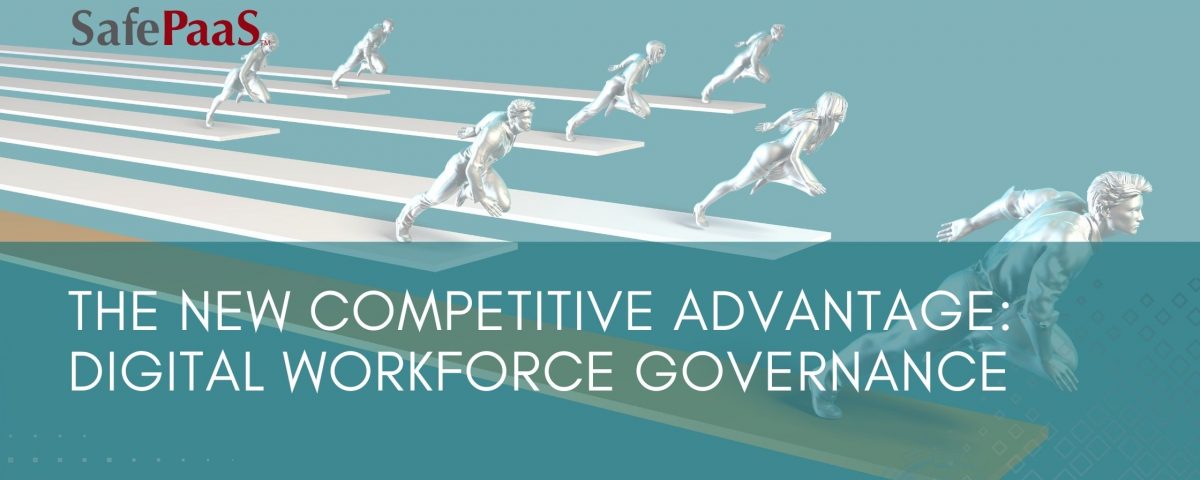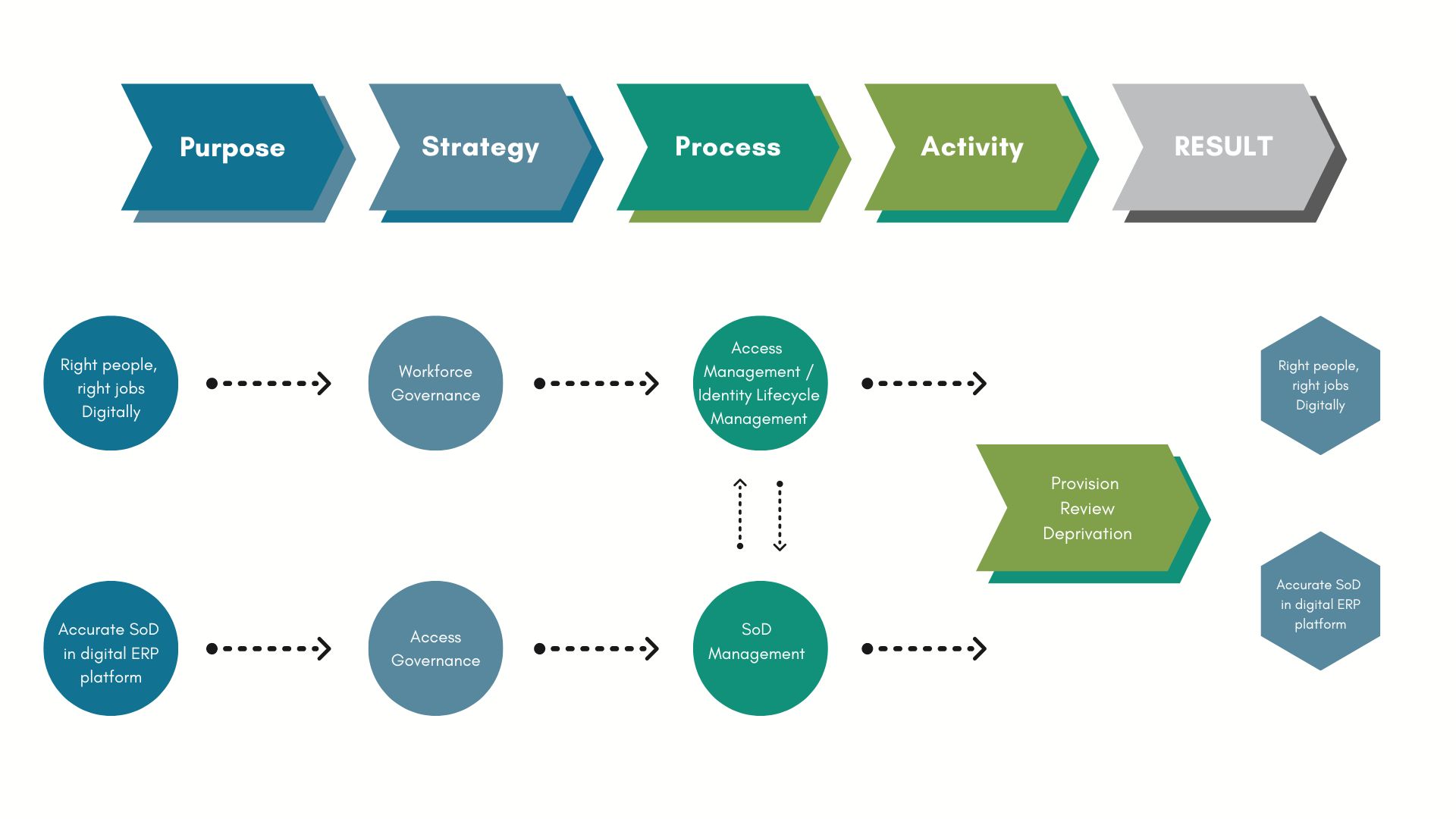Competitive advantage: Digital Workforce Governance


The new competitive advantage: Digital workforce governance
The real reason you need segregation of duties
With up to 68% of total business costs spent on your workforce, how you govern that workforce can profoundly impact your success (or failure). This asset is often not carefully planned, assessed, or optimized despite its importance. As a business matures and expands, its workforce governance strategy will have a lasting financial impact.
Workforce governance affects every aspect of a business, including compliance, cyber security, internal controls, and even the speed of innovation. Companies must find ways to effectively manage job roles and privileges to the work performed. Having the right people in the right job is the foundation of optimization.
A well-managed process of assigning job roles and privileges creates better communication, more clearly defined job roles, increased security and risk management, and greater market alignment, among many other benefits.
What is digital workforce governance?
The term "work smarter, not harder" captures workforce governance's essence.
The concept of workforce governance began in the industrial era to increase efficiency and productivity through specialization and separation of duties in a line or factory setting. There's no clear visual assembly line in a digital platform like your ERP; your factory floor is the system where your business is transacted.
Digital workforce governance refers to the processes, job roles, privileges, and policies that deliver and shape your digital workforce and guarantee its long-term success. Digital workforce governance focuses mainly on the user access lifecycle and the decisions that must be made along the way.
Why is workforce governance essential, and how it ties to Segregation of Duties.
Provisioning, reviewing, and de-provisioning user access is the basis of workforce governance and digital SoD management. Both workforce governance and Segregation of Duties management rely on fine-grained access management to optimize and protect your business.

Almost every business has a process for Segregation of Duties management, so why not turn a mandatory task to your advantage. Use your SoD review process to manage jobs and correct privileges in your digital platform to reduce risks and maximize productivity. It's a strategic workforce planning approach that starts with leadership creating a defined job role and privilege structure in their digital platform to give organizations a clear direction for future decisions.
Advantages of workforce governance
Once an effective policy-based access governance solution is in place, businesses will immediately begin reaping the benefits of workforce governance. The largest and fastest advantage will be increased productivity, as many time-wasting activities will be either reduced or eliminated. Automation will lead to fewer errors, improved security, and more consistent production. And streamlined processes lessen the workload. Other workforce governance benefits include:
Prevent financial misstatement risks: The most effective way to avoid financial reporting errors is to prevent them with robust controls. Controls, such as the segregation of duties, access controls, automated process controls, and internal audits, can help prevent errors and increase the ability to detect mistakes and fraud.
Reduced cost of compliance: Protiviti's 2022 Sarbanes-Oxley Compliance Survey found that 53% of organizations reported increased SOX compliance hours, and many companies spend $2 million or more on compliance. Reducing manual controls significantly impacts the compliance costs of an organization. Manual processes requiring the involvement of employees or auditors are not sustainable. In the long run, automated controls are more stable because they enable a repeatable, reliable, and predictable framework while lowering the cost of compliance.
Supply chain: The supply chain must be efficiently organized to generate margins. This is not possible if your workforce is not organized. Supply chain disruptions are costly and must be well organized to generate your margin. If your workforce is not organized and focused on managing suppliers and how the product you're buying from a supplier is being utilized within the company, you have a workforce problem. A simple example is creating purchase orders and paying invoices on the same day. If you are issuing purchase orders the same day as the invoice arrives, you're not following a PO process, and management doesn't know the actual costs of doing business because you never received the PO on time.
Strengthened internal controls: Internal controls maintain and protect your data, security, and compliance with regulations. Internal controls are also used to maintain accountability and safeguard your ERP against fraud and data theft. Once established, internal control automation allows you to embed the rules and processes that make up your internal controls so that they function unassisted.
Internal controls allow you to govern your workforce better because you know when policies are broken or bypassed. Therefore, you can correct mistakes and mitigate fraud. So internal controls will be improved with better workforce governance.
Improved forecasting and budgeting: Use access management data to analyze past and present to provide valuable insight into operations. This information can help you forecast trends and properly budget labor costs.
Enhanced reporting and analytics: Access metrics demonstrate the efficiency and effectiveness of onboarding, modifying roles, and de-provisioning. Measure the effectiveness of groups and discover areas that need improvement.
Compliance and risk mitigation: Reducing risk and staying compliant are essential components of any governance strategy and are often time-consuming. Workforce governance enables you to organize, optimize and track critical information and allows businesses to meet crucial compliance requirements.
Increased data protection: An effective and efficient access governance solution will help IT departments be better equipped to secure and protect employee and customer data. Workforce governance can identify the needs of every department, match skills with positions, and recruit and retain employees.
Increased efficiency and productivity: The right number of employees at all times. Organizations can have a complete picture of employee roles and privileges. This enables employees to manage customer demands effectively and reduces errors.
Improved customer service and retention: Customers get help and resolve their queries quickly and efficiently because the right people are in the right jobs. Workforce governance can help you analyze employee skill gaps and the ability to service your customer's needs. This also applies to your supply chain or any other aspect of the business; when you have your workforce strategically mapped to jobs.
Workforce Governance with SafePaaS = Access and Segregation of Duties management
SafePaaS has made the access (Segregation of Duties) governance process sustainable. Segregation of Duties management is part of conducting good governance. Reviewing and adjusting access and privileges ensures job performance.
With that mission in mind, SafePaaS built a flexible and agile process workflow that enables you to configure the SoD management process based on your business needs, automating the SoD process and making it self-service.
Workforce alignment in our current era is causing companies significant confusion and chaos about internal controls, audits, and security. And governance solutions like SafePaaS help businesses return to a point where the right people are assigned the right role and constantly perform the right job.

